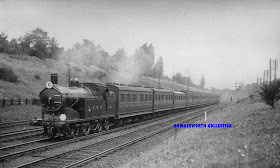I have had for the last forty years two small suitcases full of railway photographs some taken in the1920s by Cyril Hawkesworth, including some glass negatives and others collected on postcards. They were gifted to me by his dying widow around 1970 just hours before they were due to be thrown into a skip. Photographs clearly taken bu Hawksworth are set out in a separate collection. Cyril collected railway photographs from commercial companies, and where appropriate I will declare these sources. I am attempting to share them for research purposes, though it takes time to rephotograph and research each picture. Each is rephotographed digitally and enhanced, so these photographs are crisper and clearer than the originals. One photograph, of T9 4-4-0 No.300 "near Earlsfield" appears (unacknowledged) in O.S.Nock's
Southern Steam. Some books misidentify classes - I have come across two photos of U1s misnamed as N15 because the Ashford (A) and Eastleigh (E) numbering system in the early days of Southern was not understood. I use O.S. Nock's
Southern Steam, Ian Allen's
ABC of Railway Locomotives 1944 Edition (reprints are available from NRM), and the excellent Southern Email Group website. Nevertheless, I am always happy to be corrected. I will be happy for any comments about the engines featured. Cyril died unknown - he was married and moved away and after 1929 this collection stops. In time this collection will be deposited with an appropriate museum so that it survives a few more generations. Thanks to David Vidler for corrections and additions. Headcodes are given in David Wragg, The Southern Railways Handbook, appendix 1. This collection is not for profit, and apologies if I am unaware of copyright status.
.
1.SR N15 (E)801
Sir Durnore (King Arthur Class) at Victoria. From the last batch built in Eastleigh, 1928.
2. SR N15 (E)773 Sir Lavaine
3. LSWR N15 742 Camelot - one of the original Urie builds, 742 and her sisters were poor steamers and had to be given redesigned smokeboxes and valveports. Compare her with the previous two photos and you will see subtle differences. They were enormous engines, two big to fit into some eastern stations without hitting the platform edge.
4. The A above number 755 stands for Ashford, Kent so this is a class L1, later numbered 1755. A works photo showing new paint.
5. Again an Ashford engine, (A) 735 (later 1735) is class D1 though very similar to the class L1.
6. Ashford engine (A)763, class L.
7. LSWR H15 no. (E)335. The white circle headcodes could stand for London to Portsmouth/Southsea or to Exeter. The number 25 is a Nine Elms duty number
8. LSWR T9 number (E)114, Waterloo to Portsmouth.
9. LSWR N15 (E)742 Camelot. The white circle headcodes stand for express from London to either Southampton or more likely Exeter and Plymouth.
10. LSWR Class T9 no. (E) 284. . Geoff:
10 : "284 passes Esher with a Weymouth express September 1923. H. Gordon Tidey" in "The Drummond Greyhounds" Bradley 1977, p.60. In Bradley, a white catalogue number appears on the platform edge. The 'T' prefix you have noted in "Greyhounds" I understood to have been used by John Smith to distinguish negs/plates by H.Gordon Tidey, which effectively confirms the photographer and explains why it doesn't appear on your print. However, that doesn't quite square with the Wikipedia entry.
http://en.wikipedia.org/wiki/H._Gordon_Tidey
11. LSWR class S15 no. (E)498, works photo, in works photographic grey.
12. Ashford engine (A)781, class L, and interesting contrast to the class L1 above.
13. Another class L (A)776. The white circle headcodes stand for the Victoria to Ramsgate route.
14. LSWR (E)850 Lord Nelson with bright new paint. The Lord Nelsons were introduced right at the end of Cyril's period of photography, around 1928-9. The white circle headcodes may stand for Southampton t
o Andover by Eastleigh. David Vidler notes: "the restriction 1 carriages indicate an Eastern Section train". Geoff: Climbing Grosvenor Bank, out of Victoria, Eastern Section.
15. Repeat of 53.
16. The M7 (E)375.
17. NSWR class N15 (King Arthur class) 755
The Red Knight. The triple headcode suggests the Brighton to Bournemouth direct line. The 52 is the Nine Elms duty number.
18. LSWR class L12 (E)417
19. LSWR class A12 (E)618 in Strawberry Hill (David V)
20. (E)120 DV says: Eastleigh
shed - possibly 1927 when 120 was newly superheated.
21. LSWR class D15, (E)464. Eastleigh shed.
22. LSWR Class N15, (E)755 The Red Knight without nameplate, works photo. Names were added only in 1925. Naming was not an LSWR tradition and it met resistance. 736-755 were thus unnamed when first introduced.
23. LSWR Class N15, 737 King Uther without nameplates, works photo. Oil burner: DV says: can
be dated as 1921 when running as oilburner.
24. Class N15, (E)753 Melisande. Eastleigh Shed. 1926
25. LSWR, Class S15, (E)515, works photo, oilburner. DVsays:
can
be dated as 1921 when running as oilburner.
26. LSWR class A12, (E)624. The van after the first two carriages is interesting. DV says:
I think this could be an
Alton train. It is possible that it was Waterloo-Southampton via Alton but I
doubt that an A12 would have been trusted with a train that size over the
Mid-Hants line.
27. LSWR class T9, (E) 302 perhaps? The back of the photo is inscribed 'Up White Star Line'. DV says:
The
black centre to the disc indicates a special train - the Ironclad
Pantry Brake First behind the engine confirms that is a Southampton boat
train.































































